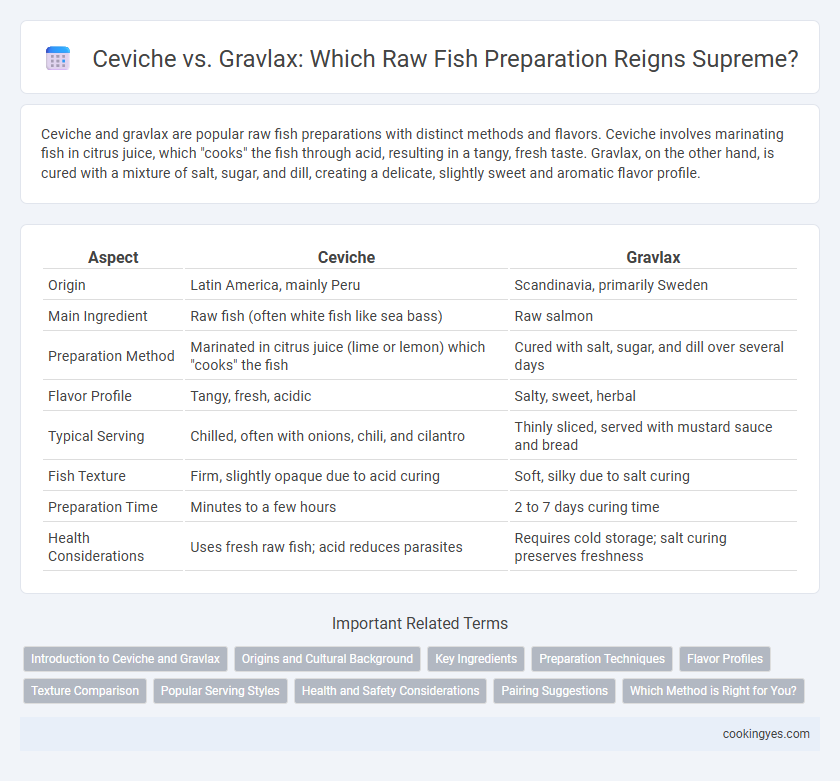Ceviche and gravlax are popular raw fish preparations with distinct methods and flavors. Ceviche involves marinating fish in citrus juice, which "cooks" the fish through acid, resulting in a tangy, fresh taste. Gravlax, on the other hand, is cured with a mixture of salt, sugar, and dill, creating a delicate, slightly sweet and aromatic flavor profile.
Table of Comparison
| Aspect | Ceviche | Gravlax |
|---|---|---|
| Origin | Latin America, mainly Peru | Scandinavia, primarily Sweden |
| Main Ingredient | Raw fish (often white fish like sea bass) | Raw salmon |
| Preparation Method | Marinated in citrus juice (lime or lemon) which "cooks" the fish | Cured with salt, sugar, and dill over several days |
| Flavor Profile | Tangy, fresh, acidic | Salty, sweet, herbal |
| Typical Serving | Chilled, often with onions, chili, and cilantro | Thinly sliced, served with mustard sauce and bread |
| Fish Texture | Firm, slightly opaque due to acid curing | Soft, silky due to salt curing |
| Preparation Time | Minutes to a few hours | 2 to 7 days curing time |
| Health Considerations | Uses fresh raw fish; acid reduces parasites | Requires cold storage; salt curing preserves freshness |
Introduction to Ceviche and Gravlax
Ceviche is a Latin American dish featuring raw fish cured in citrus juices, primarily lime or lemon, which effectively "cooks" the fish through acid denaturation. Gravlax, originating from Nordic cuisine, involves curing raw salmon with a mixture of salt, sugar, and dill, allowing the flavors to develop through a slow curing process without heat. Both preparations emphasize freshness and natural textures but differ significantly in technique and flavor profiles, with ceviche offering a tangy, zesty experience and gravlax providing a delicate, herbaceous taste.
Origins and Cultural Background
Ceviche originates from the coastal regions of Peru and is a traditional Latin American dish where fresh raw fish is marinated in citrus juices, especially lime, which "cooks" the fish chemically. Gravlax comes from Nordic countries, particularly Sweden, where raw salmon is cured with a mixture of salt, sugar, and dill, reflecting Scandinavian preservation techniques used for centuries. Both dishes highlight unique cultural approaches to raw fish preparation, with ceviche emphasizing acidity and freshness, and gravlax focusing on curing and subtle flavor enhancement.
Key Ingredients
Ceviche features raw fish marinated in citrus juices, primarily lime or lemon, which chemically "cooks" the fish, often combined with ingredients like onions, cilantro, and chili peppers for a fresh, zesty flavor profile. Gravlax is made by curing raw salmon with a mixture of salt, sugar, and dill, allowing the flavors to penetrate the fish over time without heat, resulting in a delicate, mildly sweet taste. The key distinction lies in ceviche's acid-based preparation versus gravlax's salt and herb curing process.
Preparation Techniques
Ceviche involves marinating raw fish in citrus juices, typically lime or lemon, which chemically "cooks" the fish through acid denaturation, preserving a firm texture and fresh flavor. Gravlax preparation entails curing raw salmon with a mixture of salt, sugar, and dill, allowing the enzymes to break down proteins gradually over several days, resulting in a smooth, silky texture. Both techniques emphasize preserving the fish's natural qualities but differ in chemical processes and curing duration.
Flavor Profiles
Ceviche features a bright, tangy flavor profile due to its citrus-based marinade, typically lime or lemon juice, which cures the raw fish and imparts a zesty freshness often complemented by chili, cilantro, and onions. Gravlax offers a delicate, subtly sweet and herbal taste from its curing process involving salt, sugar, and dill, resulting in a silky texture with a mild, savory finish. The bold acidity of ceviche contrasts with the smooth, aromatic complexity of gravlax, making each preparation distinct in flavor emphasis.
Texture Comparison
Ceviche features raw fish cured in citrus juice, resulting in a firm yet tender texture with a slight bite due to the acid denaturing the proteins. Gravlax, on the other hand, is thinly sliced salmon cured with salt, sugar, and dill, producing a silky, smooth, and slightly oily texture. The contrast lies in ceviche's crisp freshness versus gravlax's rich, melt-in-the-mouth quality.
Popular Serving Styles
Ceviche is traditionally served marinated in citrus juices like lime or lemon, often garnished with onions, cilantro, and chili peppers, emphasizing a fresh, tangy flavor profile popular in Latin American cuisine. Gravlax is typically thinly sliced and served cured with a dill mustard sauce, accompanied by rye bread or crispbreads, highlighting its Scandinavian roots and subtle, herbaceous taste. Both dishes showcase raw fish prepared through curing or acid-based methods, appealing to distinct regional palates and dining experiences.
Health and Safety Considerations
Ceviche uses citrus juice to denature proteins and reduce bacteria, but it does not fully kill parasites or pathogens, requiring fresh, high-quality fish for safety. Gravlax is cured with salt, sugar, and dill, which inhibits bacterial growth but also does not eliminate parasites, making freezing the fish to -20degC for at least 7 days essential to prevent infection. Both methods demand strict hygiene and sourcing from reputable suppliers to minimize risks of foodborne illnesses.
Pairing Suggestions
Ceviche pairs exceptionally well with crisp white wines such as Sauvignon Blanc or light, citrusy beers like a Belgian Witbier, enhancing its tangy, acidic flavors. Gravlax complements dry, herbal white wines like Riesling or light-bodied reds such as Pinot Noir, as well as traditional accompaniments like mustard-dill sauce and rye bread. Both dishes benefit from fresh, vibrant herbs and subtle spice notes to balance the delicate textures of the raw fish.
Which Method is Right for You?
Choosing between ceviche and gravlax depends on your flavor preferences and preparation time. Ceviche features raw fish cured quickly in citrus juice, offering a bright, tangy taste perfect for those seeking a zesty, refreshing dish. Gravlax involves curing salmon with salt, sugar, and dill over several days, resulting in a delicate, subtly seasoned flavor ideal for traditional Nordic cuisine lovers.
Ceviche vs Gravlax for raw fish preparation Infographic

 cookingyes.com
cookingyes.com